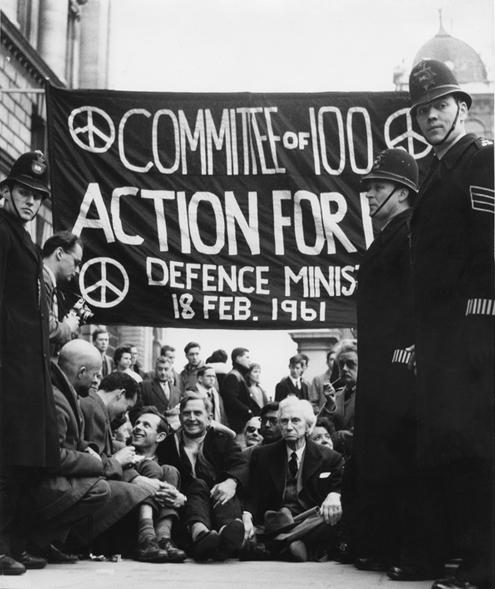Editorial: The Committee of 100
by Gertjan Cobelens

Bertrand Russell (right foreground) leads Committee march; courtesy peacebuttons.info
We are posting today (see below) three previously unpublished articles from the Committee of 100 archive, held by the IISG in Amsterdam, as part of our ongoing research into the early influence of nonviolence on the pacifist movements. During the summer of 1960, philosopher and activist Bertrand Russell was persuaded to resign his presidency of the Campaign for Nuclear Disarmament and assume the leadership of the Committee of 100, a newly planned movement for large scale nonviolent direct action against the manufacture and use of nuclear weapons. Together with Michael Scott, Ralph Schoenman, Michael Randle, April Carter and 95 other public signatories, 88-year-old Russell launched the Committee at a meeting in London on 22 October 1960. Its objective was to stop the “folly of nuclear armaments” through mass civil disobedience.
Right from the beginning the Committee of 100 strongly emphasized the nonviolent nature of the demonstrations, and anybody who wished to participate had to adhere to a long list of behavioral guidelines designed to safeguard the nonviolent integrity of the movement. Nevertheless, demonstrators expected to be arrested and charged and at the second of the sit-down demonstrations in April 1961 in London, over 800 people were arrested. That September, a week before the next mass demonstration, all one hundred committee members were summoned to court without charge for incitement to commit breaches of the peace. They were asked to sign a promise of good behavior for twelve months, but 32 refused, including Bertrand Russell, who opted to go to jail instead. The September demonstration was the largest organized by the Committee. Between 12,000 and 15,000 demonstrators flooded into the center of London, and more than 1,300 were arrested.
By now the authorities were beginning to take the Committee more seriously. Six of the younger and lesser known Committee members were arrested and charged with conspiracy and incitement to breach the Official Secrets Act. Five were imprisoned for 18 months. This heavy handed crackdown caused many signatories to resign from the Committee, and with the ebbing away of the Cuba Crisis in 1962, mass support for the activities of the Committee and the concept of unilateral nuclear disarmament also started to dwindle. In 1963 Russell resigned. In October 1968 the Committee of 100 was disbanded.
Despite its limited success the Committee would become a template for later activist organizations, especially anarchist inspired organization. In early 1962 the Committee had decided to decentralize its organization by splitting into autonomous regional committees and area working groups under the umbrella of the national Committee. Any region attracting 100 signatories could start its own Committee of 100 and plan its own actions, hence the Twickenham Committee of 100, the Croydon Committee of 100 and the Bromley and Beckenham Committee of 100, to name just a few. Next to the regional committees there were innumerable autonomous work groups who carried out an array of specialized tasks, including the Legal Action Group, Schools for Non-Violence, the Welfare Group and the 100 Book Club.
EDITOR’S NOTE: Gertjan Cobelens is our Pacifism editor, and in charge of our research project into the early influences of nonviolent theory on the European and U.S. pacifist movements. For other articles from his research please consult our WRI/IISG category.




